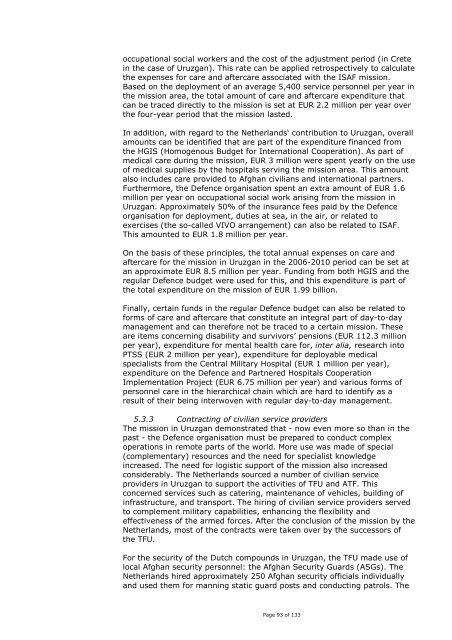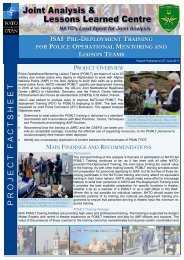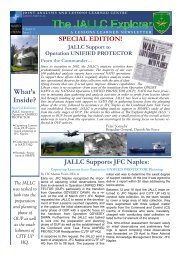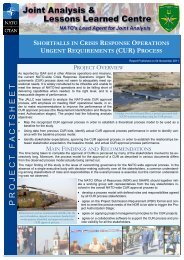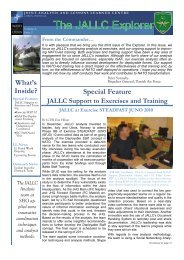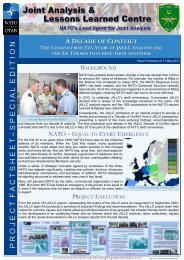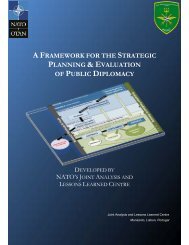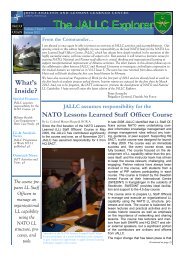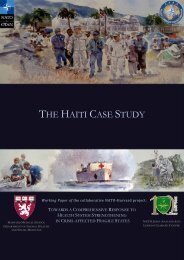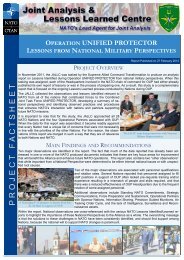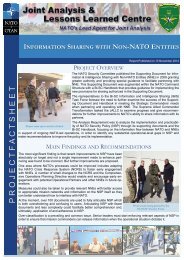of the Re<strong>in</strong>tegration Services Centre. The welfare desk of the GeneralPension Fund for Public Employees ma<strong>in</strong>ly provides assistance regard<strong>in</strong>gquestions and concerns of military war and service victims <strong>in</strong> the materialdoma<strong>in</strong>. It has been established that the organisational set-up of aftercarefor military war and service victims functions satisfactorily, and thataccessibility and awareness regard<strong>in</strong>g the welfare desk is sufficient. Thethreshold for (former) personnel to approach the relevant organisationswith a care question or concern is low. This applies to active servicemembers as well as to veterans and military war and service victims of theUruzgan mission. Reta<strong>in</strong><strong>in</strong>g and strengthen<strong>in</strong>g the current low-thresholdcare system will enable timely recognition and treatment of compla<strong>in</strong>ts,some of which only manifest themselves several years after thedeployment.Individual care is customised and both care providers and careorganisations have therefore had to deviate from exist<strong>in</strong>g procedures <strong>in</strong>some cases. It is important that these changes are eventually <strong>in</strong>corporated<strong>in</strong>to exist<strong>in</strong>g regulations and that the latter are adapted where necessary.Registration of data and mak<strong>in</strong>g available <strong>in</strong>formation also deservespermanent attention.<strong>F<strong>in</strong>al</strong>ly, it can be said that the mutual coord<strong>in</strong>ation between care providersand organisations is important and can still be improved further. Becausethe provision of aftercare is accommodated <strong>in</strong> many different places <strong>in</strong> theorganisation, there is a need for a comprehensive concept of care which<strong>in</strong>tegrates all procedures, enabl<strong>in</strong>g aftercare to become even better. Theprocess of aftercare can be optimised <strong>in</strong> the com<strong>in</strong>g years. For this effort,the <strong>in</strong>put from the Inspector-General of the Armed Forces and from theInspector of Military Health Care will be used.5.3.2 F<strong>in</strong>ancial aspects of care and aftercareThe past years have shown that it is impossible to l<strong>in</strong>k the expenditure forcare provision directly to specific deployments because of the permanentnature of the care the Defence organisation provides to active and formerservice members and the fact that care constitutes a permanent element ofday-to-day management. For this reason, no separate accounts forpersonnel care and health care are kept dur<strong>in</strong>g operational deployment. Inaddition, care is <strong>in</strong> some cases provided over very long periods of time anda need for care may manifest itself at a very late stage, mak<strong>in</strong>g it difficultto determ<strong>in</strong>e to which specific mission that particular need relates.In 2008, <strong>in</strong> retrospect and on the basis of assumptions and estimates, aneffort was made to ga<strong>in</strong> a clear <strong>in</strong>sight <strong>in</strong>to the amounts spent on care andaftercare for military personnel deployed to Afghanistan. Follow<strong>in</strong>g from theaccount of expenditure on the <strong>ISAF</strong> mission and with a view to the futureplann<strong>in</strong>g and accountability of expenditure on care and aftercare, an effortwas made to develop a methodology that will be applicable to missions <strong>in</strong>general. Us<strong>in</strong>g tariffs, part of the mission-related expenditure on care andaftercare can thus be made transparent. These tariffs have beenestablished on the basis of facts and experience and concern the extraexpenditure for care aris<strong>in</strong>g from a deployment, which can be l<strong>in</strong>ked directlyto the deployed personnel. As a pr<strong>in</strong>ciple, ‘care’ was understood to meanmedical care <strong>in</strong> deployment areas, and, <strong>in</strong> the <strong>Netherlands</strong>, treatment ofphysical and mental <strong>in</strong>jury, (extra) vacc<strong>in</strong>ation, medical exam<strong>in</strong>ations priorto deployment, post-deployment adjustment, aftercare questionnaires andreturn <strong>in</strong>terviews. This tariff was calculated at EUR 410. This amount<strong>in</strong>cludes the mission-specific vacc<strong>in</strong>ation, the medical exam<strong>in</strong>ation prior todeployment, the aftercare questionnaire, the return <strong>in</strong>terview conducted byPage 92 of 133
occupational social workers and the cost of the adjustment period (<strong>in</strong> Crete<strong>in</strong> the case of Uruzgan). This rate can be applied retrospectively to calculatethe expenses for care and aftercare associated with the <strong>ISAF</strong> mission.Based on the deployment of an average 5,400 service personnel per year <strong>in</strong>the mission area, the total amount of care and aftercare expenditure thatcan be traced directly to the mission is set at EUR 2.2 million per year overthe four-year period that the mission lasted.In addition, with regard to the <strong>Netherlands</strong>‘ contribution to Uruzgan, overallamounts can be identified that are part of the expenditure f<strong>in</strong>anced fromthe HGIS (Homogenous Budget for International Cooperation). As part ofmedical care dur<strong>in</strong>g the mission, EUR 3 million were spent yearly on the useof medical supplies by the hospitals serv<strong>in</strong>g the mission area. This amountalso <strong>in</strong>cludes care provided to Afghan civilians and <strong>in</strong>ternational partners.Furthermore, the Defence organisation spent an extra amount of EUR 1.6million per year on occupational social work aris<strong>in</strong>g from the mission <strong>in</strong>Uruzgan. Approximately 50% of the <strong>in</strong>surance fees paid by the Defenceorganisation for deployment, duties at sea, <strong>in</strong> the air, or related toexercises (the so-called VIVO arrangement) can also be related to <strong>ISAF</strong>.This amounted to EUR 1.8 million per year.On the basis of these pr<strong>in</strong>ciples, the total annual expenses on care andaftercare for the mission <strong>in</strong> Uruzgan <strong>in</strong> the <strong>2006</strong>-<strong>2010</strong> period can be set atan approximate EUR 8.5 million per year. Fund<strong>in</strong>g from both HGIS and theregular Defence budget were used for this, and this expenditure is part ofthe total expenditure on the mission of EUR 1.99 billion.<strong>F<strong>in</strong>al</strong>ly, certa<strong>in</strong> funds <strong>in</strong> the regular Defence budget can also be related toforms of care and aftercare that constitute an <strong>in</strong>tegral part of day-to-daymanagement and can therefore not be traced to a certa<strong>in</strong> mission. Theseare items concern<strong>in</strong>g disability and survivors’ pensions (EUR 112.3 millionper year), expenditure for mental health care for, <strong>in</strong>ter alia, research <strong>in</strong>toPTSS (EUR 2 million per year), expenditure for deployable medicalspecialists from the Central Military Hospital (EUR 1 million per year),expenditure on the Defence and Partnered Hospitals CooperationImplementation Project (EUR 6.75 million per year) and various forms ofpersonnel care <strong>in</strong> the hierarchical cha<strong>in</strong> which are hard to identify as aresult of their be<strong>in</strong>g <strong>in</strong>terwoven with regular day-to-day management.5.3.3 Contract<strong>in</strong>g of civilian service providersThe mission <strong>in</strong> Uruzgan demonstrated that - now even more so than <strong>in</strong> thepast - the Defence organisation must be prepared to conduct complexoperations <strong>in</strong> remote parts of the world. More use was made of special(complementary) resources and the need for specialist knowledge<strong>in</strong>creased. The need for logistic support of the mission also <strong>in</strong>creasedconsiderably. The <strong>Netherlands</strong> sourced a number of civilian serviceproviders <strong>in</strong> Uruzgan to support the activities of TFU and ATF. Thisconcerned services such as cater<strong>in</strong>g, ma<strong>in</strong>tenance of vehicles, build<strong>in</strong>g of<strong>in</strong>frastructure, and transport. The hir<strong>in</strong>g of civilian service providers servedto complement military capabilities, enhanc<strong>in</strong>g the flexibility andeffectiveness of the armed forces. After the conclusion of the mission by the<strong>Netherlands</strong>, most of the contracts were taken over by the successors ofthe TFU.For the security of the Dutch compounds <strong>in</strong> Uruzgan, the TFU made use oflocal Afghan security personnel: the Afghan Security Guards (ASGs). The<strong>Netherlands</strong> hired approximately 250 Afghan security officials <strong>in</strong>dividuallyand used them for mann<strong>in</strong>g static guard posts and conduct<strong>in</strong>g patrols. ThePage 93 of 133
- Page 1 and 2:
Final evaluationNetherlands contrib
- Page 3 and 4:
High mountainsLow mountainsPlains a
- Page 5 and 6:
Table of ContentsDutch military per
- Page 7 and 8:
Dutch military personnel deceased i
- Page 9 and 10:
Page 9 of 133
- Page 11 and 12:
1 IntroductionThe government would,
- Page 13 and 14:
The structure of the final evaluati
- Page 15 and 16:
2 The international presence in Afg
- Page 17 and 18:
insurgents in, particularly, the ea
- Page 19 and 20:
3 Netherlands policy for participat
- Page 21 and 22:
Netherlands’ presence. Furthermor
- Page 23 and 24:
“The objectives of this stabilisa
- Page 25 and 26:
In December 2005, the Netherlands g
- Page 27 and 28:
The expectation is that meaningful
- Page 29 and 30:
3.6.2 Implementation of national pr
- Page 31 and 32:
4 Implementation of the mission and
- Page 33 and 34:
tasks to fulfil in the area of secu
- Page 35 and 36:
such as the Bushmaster, that was be
- Page 37 and 38:
Afghan partner unit, at all times o
- Page 39 and 40:
northern part of Deh Rawod in 2007.
- Page 41 and 42: in large and small bases, while con
- Page 43 and 44: previously thought and comprised a
- Page 45 and 46: Apart from facilitating training an
- Page 47 and 48: If operations in close proximity of
- Page 49 and 50: As previously mentioned, the preven
- Page 51 and 52: - Between 2006 and 2010, the number
- Page 53 and 54: government of Chora in January 2010
- Page 55 and 56: At the beginning of the Dutch missi
- Page 57 and 58: intermediary of TLO and political a
- Page 59 and 60: interest for filling judicial posit
- Page 61 and 62: During the Uruzgan mission, a great
- Page 63 and 64: structurally change governance in U
- Page 65 and 66: development programmes. Before the
- Page 67 and 68: also the way in which Afghans perce
- Page 69 and 70: tailored to the real needs of the p
- Page 71 and 72: Gizab had increased and there was a
- Page 73 and 74: The DCU programme devoted and still
- Page 75 and 76: purpose of these loans, cooperative
- Page 77 and 78: In view of the lack of enthusiasm a
- Page 79 and 80: 5 Expenditure for the mission and i
- Page 81 and 82: Overview of long-term expenditure a
- Page 83 and 84: expenditure related to the deployme
- Page 85 and 86: Multi-year expenditure, Foreign Aff
- Page 87 and 88: explosive ordnance disposal, armour
- Page 89 and 90: this situation as constraining, for
- Page 91: organised at a later stage. In addi
- Page 95 and 96: Mercedes Benz terrain vehicle, the
- Page 97 and 98: 6 ConclusionsThis chapter begins wi
- Page 99 and 100: The first part of the central quest
- Page 101 and 102: At the end of 2005, the Afghan auth
- Page 103 and 104: province. This, too, was done by me
- Page 105 and 106: area, increased sales of agricultur
- Page 107 and 108: ISAF and the OEF led to extra coord
- Page 109 and 110: d. The recommendations from advisor
- Page 111 and 112: Page 111 of 133
- Page 113 and 114: Annex A, Afghanistan Compact Benchm
- Page 115 and 116: end-2010, reforms will strengthen t
- Page 117 and 118: Afghan Cultural HeritageA comprehen
- Page 119 and 120: Private Sector Development and Trad
- Page 121 and 122: Annex B, Results of the socio-econo
- Page 123 and 124: EducationTLO data:• In 2006 there
- Page 125 and 126: Overview of the number of children
- Page 127 and 128: Annex C, Chronology200522 December:
- Page 129 and 130: July: microcredit provider World Co
- Page 131 and 132: Annex D, List of abbreviations3DADZ
- Page 133: Page 133 of 133


